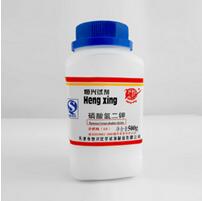Potassium Phthalate-- a commonly used chemical reagent

Dipotassium hydrogen phosphate (K2HPO3), an inorganic compound, is white crystalline or amorphous white powder in appearance. In contrast to alcohol, K2HPO3 is soluble in water, solution of which is slightly alkaline. With hygroscopicity, it could be auto-liquefiable at high temperature. At 204℃, the molecule was dehydrated and converted to potassium pyrophosphate. 1% aqueous solution of K2HPO3 has a pH of 8.9.
Mainly used in medicine industry, K2HPO3 could be developed as corrosion inhibitor for antifreeze, nutrient for antibiotic medium, phosphorus and potassium regulator for fermentation industry, feed additive, etc. In the food industry, it is used as raw material for the preparation of alkaline water for pasta products, fermentation agent, flavoring agent, leavening agent, milder and alkaline agent for dairy products, yeast food. K2HPO3 also can be used as deiron agent for preparation of talcum powder. In addition, K2HPO3 was used as water treatment agent, pH regulator, a buffer chelating agent as well as a feed additive. Furthermore, K2HPO3 can also be used as phosphating treatment of metal and plating additive.
When it turns to the production of K2HPO3, industrial production is made by neutralizing phosphoric acid with potash solution, or by neutralizing phosphoric acid with potassium carbonate solution and then by neutralizing phosphoric acid with potash solution.
1. Neutralization method
The solid caustic potassium was mixed into 30% water solution, which was clarified and filtered to remove impurities. After measurement, it was added into the anti-corrosion reaction tank. After stirring, an appropriate amount of 50% phosphoric acid solution was added slowly, and the neutralization reaction was carried out at 90 ~ 100℃.Heating to 120 ~ 124℃ for concentration, until the solution concentration reaches the required range, then filtering to remove the insoluble matter. The clarified filtrate was cooled to below 20℃ and crystallized. After centrifugation, the filtrate was slightly air-dried to produce dipotassium hydrogen phosphate.
2. Potassium carbonate method
After continuous agitation, potassium carbonate solution was added to 30% phosphoric acid solution for reaction, and the neutralization end point was pH 8.5-9.0 (phenolphthalein indicator just showed red).The neutralization solution was concentrated to 120 ~ 124℃, then filtered to remove the insoluble matter, and then cooled to below 20℃ for crystallization. Centrifugal separation, drying products, mother liquor sent to the neutralization process reuse.
Reference
[1]. U.S. Environmental Protection Agency (USEPA), Air Quality Criteria for Ozone and Related Photochemical Oxidants, EPA/600-AP-93/004, USEPA, Washington, DC, 1996.
[2]. M. Lippmann and G. D. Thurston, Sulfate concentrations as an indicator of ambient particulate matter air pollution for health risk evaluations. J. Exposure Anal. Environ. Epidemiol. 6, 123–146 (1996).
[3]. R. T. Burnett et al., Associations between ambient particulate sulfate and admissions to Ontario hospitals for cardiac and respiratory diseases. Am. J. Epidemiol. 142, 15–22 (1995).


